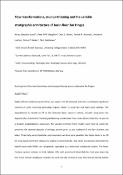Options
Flow transformations, Mud Partitioning, and the Variable Stratigraphic Architecture of Basin-Floor Fan Fringes
Alternative Title
Flow transformations and mud partitioning across submarine fan fringes
Date Issued
2023-09-01
Date Available
2024-01-22T16:58:42Z
Abstract
Highly efficient sediment gravity flows can bypass mid-fan channels and lobes and deposit significant volumes of sand, mud, and particulate organic matter in outer-fan and basin-plain settings. The Serpukhovian to Bashkirian fill in the Shannon Basin, western Ireland, includes deep-water fan deposits (Ross Sandstone Fm) that gradationally overlie basin-floor shales (Clare Shale Fm). As part of a broader progradational succession, the upward transition from muddy basin floor to sandy fan preserves the stacked deposits of settings present prior to, and outboard of, mid-fan channels and lobes. Three fully cored boreholes and associated wireline data constrain the facies tracts in an 18-km-long panel oriented oblique to original depositional dip. Two distal successions dominated by hybrid event beds (HEBs) are recognized, separated by a prominent condensed section. The lower Cos-heen system includes m-thick, tabular HEBs with prominent linked debrites that pass down dip into much thinner sandstones overlain by sand-speckled mudstone caps that thicken distally before thinning. The latter are interpreted as secondary mudflows released following reconstitution of more thoroughly mixed sections of the up-dip linked debrites. Significant bypass and accumulation of mud by this mechanism helped heal local topography and maintain a relatively flat sea floor, promoting an overall tabular geometry for the deposits of larger volume hybrid flows reaching the distal sector of the basin. The overlying distal Ross system fringe is characterized by very fine- to fine-grained sandstones and is lateral to compensationally stacked lobes farther to the west. It has a progradational (at least initially) stacking pattern, facies transitions developed over shorter length scales, and includes outsized event beds, but these are thinner than those in the Cosheen system. Common banding and evidence for turbulence suppression by dispersed clay rather than entrained mud clasts indicate that these were transitional flows. In this case, event beds are inferred to taper distally, with significant mud emplaced by plug flow retained as caps to sandy event beds rather than bypassing down-dip. Different flow transformation mechanisms thus impacted how mud was partitioned across the fringe of the two systems, and this influenced bed geometries, larger scale bed stacking patterns, and stratigraphy. Whereas the flow-efficiency concept stresses the ability of flows to carry sand in a basinward direction, it is also imperative to consider the variable efficiency of mud transport given the operation of clay-induced flow transformations. These can either promote bypass or trigger premature fallout of mud, with implications for how systems fill accommodation, bed-scale facies transitions, and the burial and preservation of particulate organic carbon fractionated along with the clay in deep-water system fringes.
Sponsorship
Science Foundation Ireland
Other Sponsorship
Geological Survey Ireland (GSI) Griffith Geoscience Award
Equinor ASA
Type of Material
Journal Article
Publisher
Society for Sedimentary Geology
Journal
Journal of Sedimentary Research
Volume
93
Issue
9
Start Page
656
End Page
692
Copyright (Published Version)
2023 Society for Sedimentary Geology
Language
English
Status of Item
Peer reviewed
ISSN
1527-1404
This item is made available under a Creative Commons License
File(s)
Loading...
Name
Obradors-Latre et al 2023 Open Access.pdf
Size
5.96 MB
Format
Adobe PDF
Checksum (MD5)
04f19df9a5ee1f2d5fa69c7ff2c36a77
Owning collection